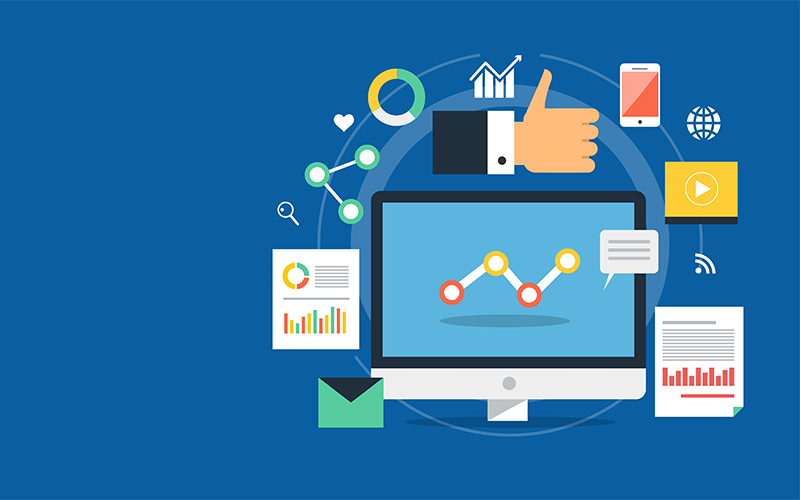Web & Social Analytics
Five emerging trends shaping digital analytics
Businesses are increasingly making decisions based on real-time data, which allows them to understand customer behaviour and market dynamics for product development, marketing, and sales promotion. With data produced in the magnitude of zettabytes, it is now a challenge for businesses to harvest important and relevant information from that chunk of data.
Digital data analysis has been around for many years, but with increasing volume, new trends are emerging that will shape its future.* Let’s look at the latest trends in digital analytics.
- Automation
- Democratisation
- User experience
- Automated versus fragmented systems
- Analytics as a core business function
Data is only as relevant as its quality. Low-quality and unstructured data is an overhead rather than an asset. With vast amounts of data produced, it is imperative to automate the process of accessing and gathering raw data to derive valuable insights.
Valuable information helps the management focus on actions that drive top-of-the-line growth. It also helps the mid- and lower-level teams avoid mundane tasks and contribute to more pressing matters. Automation complements machine learning and data science for predictive analysis.
Data automation and analytics is not a science that is known only to experts. With easy-to-use analytics platforms, anyone in the team can analyse data and make decisions accordingly. You don’t need to hire specialist IT resources to interpret data. Be it the HR, finance, marketing, or business analysis teams, everyone can work equally well with modern analytics systems.
With simple drag-and-drop analytics systems, data analysing capabilities are emerging as an asset to organisations. It frees up the analytics team to upskill themselves and contribute to the larger picture as a result of quick data interpretation through automation and analytics.
Application builders and users are fast realising that user experience is as relevant to B2B customers as it is to B2C customers. Data analytics applications are now cloud based, intuitive, and compatible across different platforms such as desktops, laptops, smartphones, and tablets.
B2B users also require no-code systems that are easy to use and skip the need for technical expertise to operate. One-click results, drag-and-drop buckets, and intuitive layouts are significant trends in digital analytics.
Multiple systems with proliferating data can make data analysis complex. It requires the users to be proficient in all the systems. In addition, it is expensive to operate and integrate these systems and monitor their output. Businesses are now integrating all the systems for data analytics into a unified platform where users get an end-to-end view and are trained to operate a single system. It reduces the total cost of ownership, the number of human resources required, and adds more value to the data produced.
Data analytics is no longer an optional feature but a necessity for organisations that want to stay ahead of the competition. The culture of cultivating data within and across organisations will lead to positive business growth.
With the COVID-19 pandemic, many organisations realised that analytics based on historical data are not sufficient. They need forward-looking data and analytics to deal with disruptive change and radical uncertainty.With predictive analysis, companies will be able to foresee future challenges. One of the examples could be to anticipate and predict customers’ moves even before they make one.
For example, one of the largest consulting firms in the world wanted a better view of their marketing campaigns’ effectiveness. Read the case study of how Infosys BPM built a hyper-automated solution to provide the big picture across channels and helped the company save costs and time.
How Infosys BPM can help?
Being at par with the latest trends, Infosys BPM Digital Analytics service partners with businesses and organisations to:
- Deep dive and generate actionable insights from unstructured online data
- Transform their analytics journey through improved customer satisfaction and optimisation of digital assets to serve consumers better
Our offerings include:
- Web analytics
- Social media analytics
- Campaign analytics
- Social and web reporting
- Industry-based hyper automated social media analytics solution and more
*For organisations on the digital transformation journey, agility is key in responding to a rapidly changing technology and business landscape. Now more than ever, it is crucial to deliver and exceed on organisational expectations with a robust digital mindset backed by innovation. Enabling businesses to sense, learn, respond, and evolve like a living organism, will be imperative for business excellence going forward. A comprehensive, yet modular suite of services is doing exactly that. Equipping organisations with intuitive decision-making automatically at scale, actionable insights based on real-time solutions, anytime/anywhere experience, and in-depth data visibility across functions leading to hyper-productivity, Live Enterprise is building connected organisations that are innovating collaboratively for the future.






